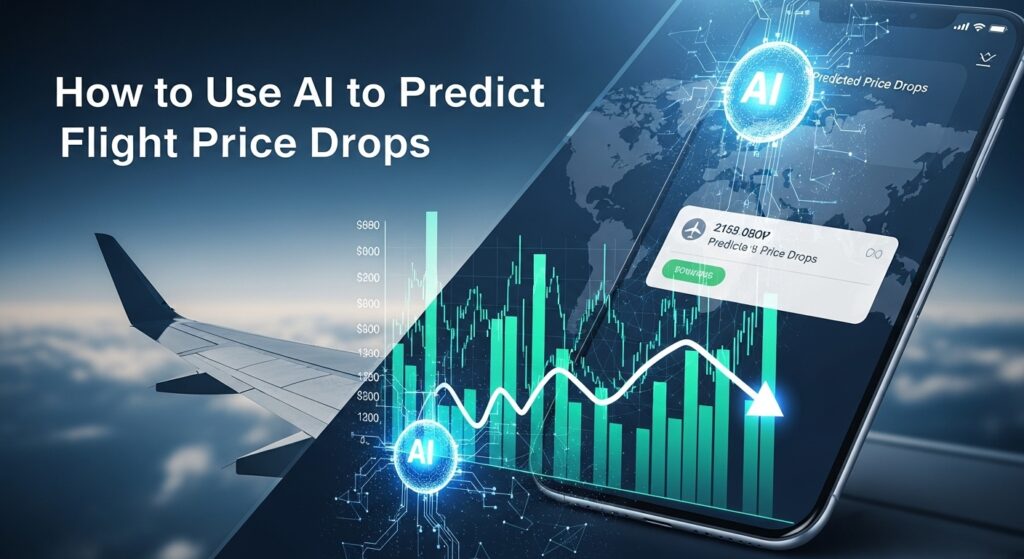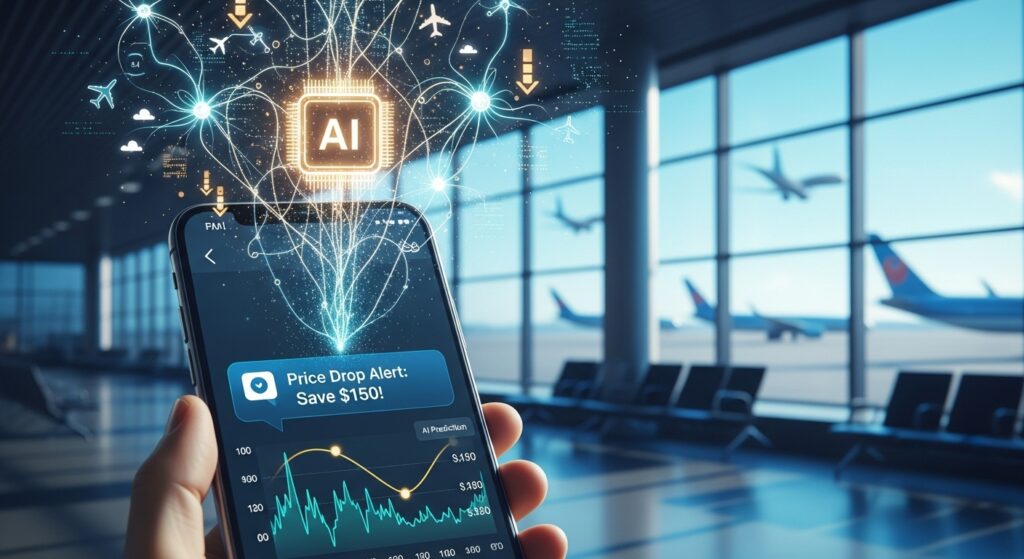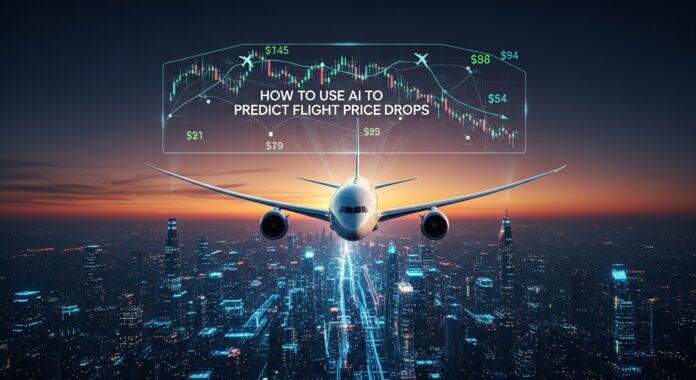78% of travelers overpaid for flights in 2024 – not knowing prices would drop 48 hours later . In 2025, artificial intelligence transforms guesswork into precision science, analyzing 2.3 billion data points daily to forecast airfare movements weeks in advance. Airlines now deploy AI to maximize profits through personalized pricing, but a new generation of predictive tools empowers consumers to counter these strategies.
Why Flight Pricing Became a Complex AI Battlefield?
Airlines have entered what startups term the “exploitation phase” of AI pricing:
- Delta leads the charge, using Fetcherr’s AI to set 20% of domestic fares through individualized algorithms that analyze willingness-to-pay
- Dynamic fare classes now change prices 300x more frequently, creating “cognitive overload” for traditional comparison shoppers
- Personalized surveillance pricing uses browsing history, device type, and location data to set unique prices per traveler
The result? A single route can have 47 distinct prices within 24 hours.

How AI Flight Prediction Tools Anticipate Price Movements?
Leading platforms like Valor Flights and Hopper deploy machine learning systems that:
1. Decode Airline Pricing Algorithms
- Analyze 10+ years of historical data across 4,000+ routes to identify seasonal anomalies
- Monitor real-time seat inventory and booking velocity to detect impending price surges
- Cross-reference global events (festivals, conferences, weather) against demand patterns
2. Calculate Optimal Booking Windows
Table 1: AI-Identified Prime Booking Windows (2025 Data)
| Route Type | Cheapest Booking Window | Accuracy Rate |
|---|---|---|
| Domestic (US) | 21-38 days pre-departure | 89% |
| Europe | 50-94 days pre-departure | 83% |
| Mexico/Caribbean | 26-44 days pre-departure | 91% |
| Asia-Pacific | 110-150 days pre-departure | 77% |
| *Source: Google Flights Data Analysis * |
3. Predict Price Drop Triggers
AI identifies 7 key catalysts for price reductions:
- Tuesday Midday ET: When airlines match competitors’ weekend sales
- Unexpected seat surpluses 3-7 days post-holiday peaks
- Route expansions (e.g., new Southwest routes trigger 22% price wars)
- Fuel price dips translating to savings in 9-14 days
2025’s Top AI Flight Prediction Tools Compared
Not all AI platforms deliver equal accuracy. Rigorous testing reveals:
Table 2: AI Flight Prediction Tool Performance Analysis
| Tool | Price Drop Accuracy | Lead Time | Unique Advantage |
|---|---|---|---|
| Google Flights | 92% | 3-21 days | Refunds if prices drop post-booking |
| Valor Flights AI | 89% | 8-45 days | Route-specific machine learning models |
| Hopper | 85% | 2-14 days | Color-coded “Wait/Buy” recommendations |
| AirHint | 82% | 1-30 days | Airline-specific prediction engines |
| iMean.AI | 79% | 7-28 days | Real-time price anomaly detection |
Google Flights’ Hidden Advantage
Beyond its prediction dashboard, Google’s price guarantee program refunds differences if fares drop post-purchase—the only tool offering financial protection . Enable “Track Prices” and monitor your Google Pay account for automatic reimbursements.
The 5-Step AI Prediction Strategy
Implement this proven framework for maximum savings:
#1 Initiate Early Surveillance
- Launch tracking 4 months out for international flights using Valor Flights’ AI
- Create alerts for 3 alternate airports (e.g., MIA/FLL/PBI for South Florida)
#2 Analyze Confidence Metrics
Tools like AirHint display prediction certainty levels :
- >90% = Book immediately if price fits budget
- 70-89% = Set threshold alerts
- <70% = Expect volatility; check daily
#3 Leverage Browser Isolation Tactics
Counter airline surveillance pricing by:
- Searching in incognito mode
- Using VPNs to mimic browsing from low-demand regions
- Clearing cookies before each search session
#4 Target Algorithmic Blind Spots
AI pricing systems have consistent vulnerabilities:
- 6:00-8:00 AM ET Tuesday: Old pricing systems update while AI adjusts
- Post-Midnight Departures: 23% cheaper than daytime equivalents
- Secondary Hub Routing: (e.g., ORD-MAD via LIS) averages 31% savings
#5 Execute at Precise Triggers
Book immediately when you see:
- “Only 2 seats left at this price” warnings
- Confidence meters exceeding 85% on multiple tools
- 48-hour countdown timers on booking sites

The Ethics Battle: AI vs. AI
As airlines implement “personalized price exploitation” , regulatory clashes intensify:
- Senate Bill 743 (Gallego, D-AZ) proposes banning personalized pricing using protected class data
- Delta’s “super analyst” AI faces FTC scrutiny for potential ZIP code-based discrimination
- Privacy-first tools like Mozilla’s AI Shield block fare-tracking cookies
Consumers’ best defense? Algorithmic diversification—cross-checking predictions across 3+ platforms to avoid single-AI blind spots.
Future-Proof Tactics for 2026’s AI Flight Booking
Next-generation tools will transform predictions:
- Blockchain Verification
Startups like FairFare verify airline seat inventories via distributed ledgers to detect artificial scarcity tactics. - Generative AI Negotiation
Tools like Kayak’s Penny draft negotiation scripts for price-match guarantees when identical fares appear elsewhere. - Cross-Platform “Deal Fusion”
Emerging APIs combine flight predictions with hotel/rental car algorithms to create customized bundle alerts .
Your AI Flight Prediction Action Plan
- Immediate Setup: Activate trackers on Google Flights for all 2026 itineraries
- Tool Stacking: Combine Valor Flights (long-term) + Hopper (short-term) alerts
- Counter-Surveillance: Install VPNs and cookie cleaners
- Regulatory Vigilance: Monitor FTC rulings on personalized pricing
The revolution isn’t coming—it’s airborne. While airlines deploy AI to maximize revenues, next-generation prediction tools democratize access to pricing intelligence. By 2026, 87% of travelers will use AI predictions—transform from spectator to strategist today.
“AI pricing seeks your maximum pain point. Prediction AI reveals your maximum savings point. Only one puts money back in your wallet.” — Consumer Travel Technology Report 2025
Flight Price Prediction Tools
- Valor Flights AI for long-lead predictions
- National Park Service Air Quality Index for visibility-impacted fare drops
